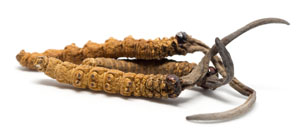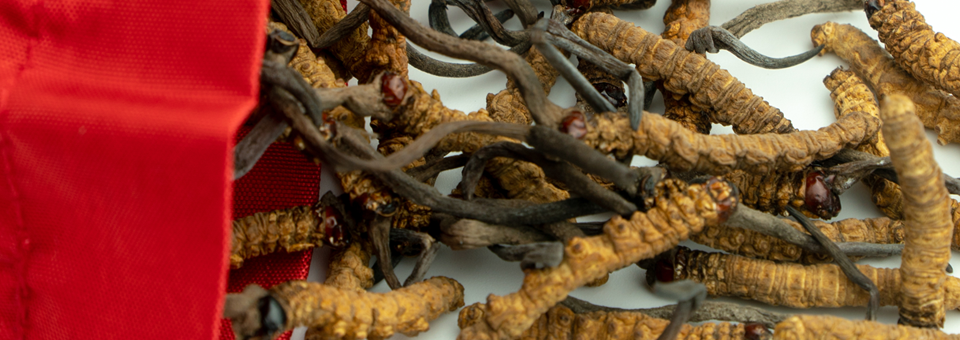I rarely — if ever — use the word “cure-all…”
But when a natural ingredient has been proven by almost 3,000 peer-reviewed studies to be more powerful than any drug Western medicine can offer, I feel safe using the term.
I’m talking about a rare Tibetan fungus that only grows in the highest peaks of the Himalayan mountain range.
For thousands of years, this fungus was reserved exclusively for Asian royalty and considered to be more valuable than gold.
And it still is…
Today it’s worth three times its weight in gold.1

Cordyceps mushroom has amazing health benefits.
Traditional Chinese healers used this unique mushroom to increase energy and enhance sexual vitality. They called it yartsa gunbu, which translates to “summer grass, winter worm.”
It got the name because it grows on the backs of burrowing caterpillars.
But you may know it by its more familiar name — Cordyceps sinensis.
In a moment, I’ll share the best ways to supplement with Cordyceps. But first let’s look at what makes this mushroom so magical.
Magic Mushroom’s Powerful 1-2 Healing Punch
Villagers in the Himalayan mountains say Cordyceps can slow aging and help fight against almost every disease. Here’s the one-two punch that makes this fungus so powerful.
- It gets oxygen where it’s needed in your body. This is the key to today’s chronic disease. I like to think of Cordyceps as an oxygen supplement.
Research shows that consuming this medicinal fungus switches on genes that increase oxygen delivery to your cells. In one study of 30 elderly patients, Cordyceps sinensis significantly improved the amount of oxygen the subjects could assimilate.2 A second study showed that Cordyceps sinensis increased cellular oxygen absorption by up to 40%.3
Meanwhile, a 2016 study from the University of North Carolina at Chapel Hill showed that daily Cordyceps supplementation increased the maximum oxygen intake in adults after just three weeks.4
- It controls inflammation. This is perhaps the most important thing you can do to prevent premature aging. While some inflammation is necessary for the body to heal itself, too much produces the diseases of aging.
Cordyceps has a potent anti-inflammatory effect thanks to a compound known as cordycepin. Research shows that when human cells are exposed to the cordycepin, certain proteins that increase inflammation in your body are turned off.5
6 Solutions for Your Biggest Health Concerns
-
Increases power to your most vulnerable organ — your lungs. Lung power is the No. 1 predictor of how long you’ll live. How well you breathe determines how long you’ll stay active and healthy. A study published in the journal Chest found that the better your lungs work, the less likely you are to die of any cause.
The best way to tell how powerful your lungs are is a measurement called VO2 max. That’s because VO2 max measures the amount of oxygen your lungs can use while you’re exercising at your maximum capacity. And the more oxygen you can get to your body, the better your body works.
-
Lowers blood sugar and improves insulin resistance. Cordyceps contains a special kind of sugar that supports healthy blood sugar. With diabetes, your cells resist insulin because they can’t store any more sugar. Cordyceps improves insulin sensitivity and blood sugar levels.6 As energy metabolism increases, cells burn glucose faster and your blood sugar levels stay within the normal range.
In one study patients were given 3 grams of Cordyceps daily. By the end of the trial, 95% showed improvement in their blood sugar profiles. But only 54% of the control group given conventional treatments showed improvement.7
-
Improves heart function. Numerous studies demonstrate that Cordyceps can lower blood pressure and correct heart rhythm disturbances like arrhythmia and chronic heart failure. The reason it can stabilize arrhythmia is due to the presence of adenosine and other nucleosides, which have a pervasive positive effect on coronary circulation.8
Strengthens the immune system and protects lungs. Researchers in South Korea gave Cordyceps or a placebo to 79 healthy subjects every day for eight weeks. Before and after the study they tested blood samples for natural killer cells. After two months, the group that took the mushroom showed a significant 18% improvement from baseline of NK cells compared to the placebo group.9 NK cells are vital because they hunt down and detect virus-infected cells in the body.
-
Can help cancer patients. Cordyceps mushrooms are rich in polysaccharides, a kind of carbohydrate that possesses powerful anti-cancer properties.10 This makes it an impressive cancer-fighter.
Clinical trials conducted by researchers at Stanford University showed that Cordyceps decreased tumor size in 50 lung cancer patients by 46%.11 And a Chinese study reported that Cordyceps helps fight the growth and spread of cancer cells.12
- Is known as the Viagra of the Himalayas. Men and women have taken Cordyceps for at least 2,000 years for sexual dysfunction and as a libido enhancer. Studies show that men who take Cordyceps have higher testosterone levels and higher sperm counts.13
Looking for Cordyceps Online? – Buyer Beware
You can find Cordyceps supplements in capsule, liquid or as a tea. But when choosing a supplement, always check the source.
- Shady distributors looking to get rich quick grow Cordyceps in labs. These supplements use different fungal species and have less potency.
- Some Cordyceps supplements have been found 50-times weaker than natural, wild sources. I advise that you avoid any supplements that say “similar to” on the label.
- As a supplement, I recommend wild-harvested Cordyceps from Tibet. Take 2 to 5 grams twice daily for best results.
- Cordyceps are generally considered safe. But if you are pregnant or breast-feeding or take blood thinners, talk to your doctor first.
To Your Good Health,

Al Sears, MD, CNS
1. Anderson D and Hou CY. “The world’s most valuable parasite, caterpillar fungus, can cost up to $63,000 per pound.” Business Insider. March 7, 2019.
2. Mishra RN and Upadhyay Y. “Cordyceps sinensis: The Chinese Rasayan-current research scenario.” Int J Res Pharma Bio Sci. 2011:2(4):1503-1519.
3. Lou Y, et al. “Cardiovascular pharmacological studies of ethanol extracts of Cordyceps mycelia and Cordyceps fermentation solution.” Zhong Cao Yao. 1986;17(5):17-21,209-213.
4. Hirsch KR, et al. “Cordyceps militaris improves tolerance to high intensity exercise after acute and chronic supplementation.” J Diet Suppl. 2017;14(1):42-53.
5. Park SY, et al. “Anti-inflammatory effects of Cordyceps mycelium (Paecilomyces hepiali, CBG-CS-2) in Raw264.7 murine macrophages.” Orient Pharm Exp Med. 2015;15(1):7-12.
6. Balon T, et al. “A fermentation product of Cordyceps sinensis increases whole-body insulin sensitivity in rats.” J Altern Complement Med. 2002;8(3):315-323.
7. Guo QC, et al. “Clinical observations of adjunctive treatment of 20 diabetic patients with jinshuibao capsule.” J Admin Trad Chinese Med. 1995:5(suppl):22.
8. Holliday J, and Cleaver M.” Medicinal value of the caterpillar fungi species of the genus Cordyceps (Fr.) Link (Ascomycetes). A review.” Int J Med Mushr. 2008;10(3):219-234.NoPubMedID
9. Jung S, et al. “Immunomodulatory effects of a mycelium extract of Cordyceps (Paecilomyces hepiali; CBG-CS-2): A randomized and double-blind clinical trial.” BMC Complement Altern Med. 2019: (19);77.
10. Chan G, et al. “The effects of beta-glucan on human immune and cancer cells.” J Hematol Oncol. 2009 Jun 10;2:25.
11. Zhu J, et al. “The scientific rediscovery of a precious ancient Chinese herbal regimen: Cordyceps sinensis: Part II.” J Altern Complement Med. 1998;4(4):429-457.
12. Chen Y et al. “Ecology-based screen identifies new metabolites from a Cordyceps colonizing fungus as cancer cell proliferation inhibitors and apoptosis inducers.” Cell Prolif. 2009;42(6):838-847.
13. Lin B, Li S. Cordyceps as an Herbal Drug. In: Benzie IFF, WachtelGalor S, editors. Herbal Medicine: Biomolecular and Clinical Aspects. 2nd edition. Boca Raton (FL): CRC Press; 2011. Chapter 5.

